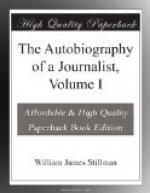Of all the English artists of that day with whom I became acquainted, Pyne impressed me as by a considerable measure the broadest thinker, and, except Turner in his water-color, the ablest landscape painter; old John Linnell in this respect standing nearest him in technical power, with a more complete devotion to nature and her sentiment. In Harding’s work I took no interest; his conventions and tricks of the brush repelled me, and generally his work left me cold and discouraged, for this is the effect of wasted cleverness, that it disheartens a man who, knowing that his abilities are less, finds the achievement of cleverer men so poor in what satisfies the artist of feeling. In it I saw an exaggeration of Pyne’s defects and the caricature of his good qualities. Creswick had a better feeling for nature, but convention in his methods gave place to trick, and I remember his showing me the way in which he produced detail in a pebbly brookside, by making the surface of his canvas tacky and then dragging over it a brush loaded with pigment which caught only on the prominences, and did in a moment the work of an hour of faithful painting.
A painter who taught me more than any other at that time was Edward Wehnert, mainly known then as an illustrator, and hardly remembered now even in that capacity. Attracted by one of his water-colors, I went to him for lessons, which he declined to give, while really giving me instructions informally and in the most kindly and generous way, during the entire stay I made in London. Among all the artists I have known, Wehnert’s life was, with the exception of Sexton’s, the most pathetic. His native abilities were of a very high order, and his education far above that which the British artist of that day possessed. He was a pupil of Paul Delaroche, and the German blood he had from his father gave him an imaginative element which the Englishman in him liberated entirely from the German prescriptive limitations, while there was just enough of the German poet in him to give his




